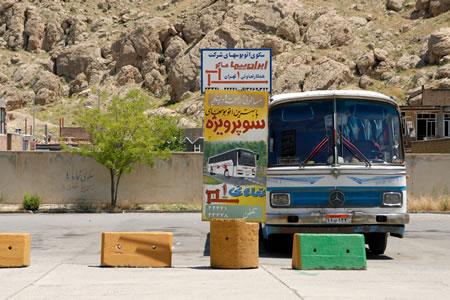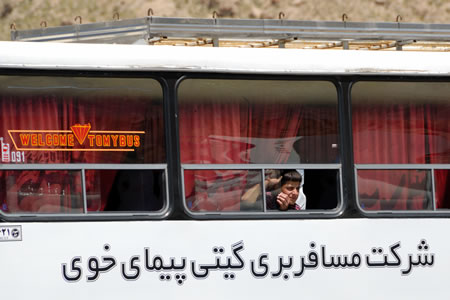English | Dutch |
|
| Crossing from Turkey to Iran | |
Tabriz (Iran), Juni 23rd 2007 |
|
It is Saturday morning 06.15 am when the alarm clock goes off. Today is an exciting day for us. We are still in Dogubayazit (Turkey) but will cross the border today to Iran. A border crossing is always exciting, but crossing the border into Iran is thrilling. Today is also the first day that Ivonne is veiled. We did visit Iran before (in 1998) and at that time the dressing regulations were quite simple. The woman needed to wear a black tent-like dress that showed no body figure at all. On her head she had to wear a black headscarf that only showed her face (and no hair). See also article: “To set out for Iran”. The question at this moment is: what are the regulations today?
We heard a couple of months ago in the news that the Iranian government was planning to look on more strictly again to the dressing regulations. Last years, the Iranian women went step by step a little bit further in relation to the freedom of dressing. It started with showing some hair from below the headscarf. The next step was that the dresses got some shape, in where the body figure was visible. Now it seems that a lot of women use make-up and even wear sandals. Ivonne wants to have a dress that is acceptable by both the more conservative Iranians, and the more western orientated Iranians. Besides that, the dress must be comfortable. This means preferably not in black because of the heat. We decided to do the shopping for the dress in Istanbul. We have bought for Ivonne a long blue skirt (till the ankle), a beige blouse (till the knees) and a beige headscarf. We hope this will be acceptable for all Iranians. |
|
 |
|
The old Mercedes bus that must bring us from Maku to Tabriz. |
|
After checking out in the hotel, we walk with our backpacks to the street in Dogubayazit where all Dolmuces (shared taxi, often a minivan) leave to the border. We have decided to take a minibus till the border and cross the border by foot. The other alternative is that you take an international bus that crosses the border. In that case you take the risk of having delays at the border, because the whole bus (with all 50 passengers) must go through the immigration and customs. The delays can be even worse if the paperwork of one of the fellow passengers is not ok. Our minibus to the border leaves when the bus is full (20 passengers). One of the passengers is an Iranian woman who is dressed in a black chador (most conservative way of dressing in Iran). Ivonne is a little bit anxious and hopes that this is not the forerunner of how Iranian women are dressed today. In that case Ivonne’s dress is a bad choice. After a ride of 30 minutes we arrive at a big iron gate with a big Turkish flag on it. We get out of the minibus and start walking through the gate in the direction of the Turkish emigration. We line up at the emigration counter and use this time the exchange our last Turkish Lira’s for Iranian Rials at one of the black market money changers. As usual for a very bad rate. Ten minutes later, our passports are stamped and we officially left Turkey. We start walking again for 5 minutes over a road that is fenced at both sides. When we arrive at the next gate we are welcomed by a big sign with the text (with spelling mistake): “Well Come in Iran”. The text is accompanied with the portraits of both the former Ayatollah Khomeini (died in 1989) and the present Ayatollah Khamenei. A big gate shoulders aside and we enter Iranian soil. Somebody of the Iranian police checks if we have a visa and directs us to the Iranian immigration desk. At the moment we want to line up, an English speaking young man approached us and asks for our passports. After a short look in our passports, he asks us to follow him to his office. We are very friendly welcomed in his office and he explains that he is working for the tourist information and that he is going to help us to get through the immigration procedures. We take a seat in a leather fauteuil that is still sealed in its original packaging. The young man fills in all papers and arranges the stamp in our passport. We are now officially in Iran. Just after the immigration is a small bank. We change some money to cover the next couple of days. Officially we should also go to the customs where they check the baggage. But there is no active custom at the moment. So before we know we passed all official procedures and are finally back in Iran. The whole procedure from the Turkish emigration to where we are now, took a little bit more than an hour. | |
 |
|
An Iranian boy waving goodbye on the Maku bus terminal. |
|
| Like in 1998 all Iranian people we met so far are very, very friendly. We really have the feeling that we are welcome in Iran. We leave the immigration building and take a taxi to the nearby village of Bazargan. At the Iranian side of the border we see hundreds of trucks, waiting in long lines to cross the border. The waiting time for these truck drivers must be several days. From Bazargan we take another taxi to the little city of Maku, 15 kilometres further where we can take a bus to Tabriz, the second biggest city of Iran. When we enter Maku by taxi, we can get a good feeling about the present dress code in Iran. It is striking to see that the dress code differs between the young ladies and the older ladies. Most of the older ladies are wearing the same cloths as they did in 1998 (black long dresses and chadors). On the other hand, the young ladies wear mainly black trousers with a shaped black trench coat. On their head they wear a black headscarf that does not fully cover their hair. Also make-up is very popular. The taxi driver drops us at the bus terminal of Maku, where we buy two tickets to Tabriz (4 hours drive) for one US-dollar. We have to wait one hour before the bus leaves. We use that time to celebrate our arrival in Iran with the local soft drink ZamZam. ZamZam was our favourite soft drink back in 1998. After one drink we know for sure that it is not going to change! | |